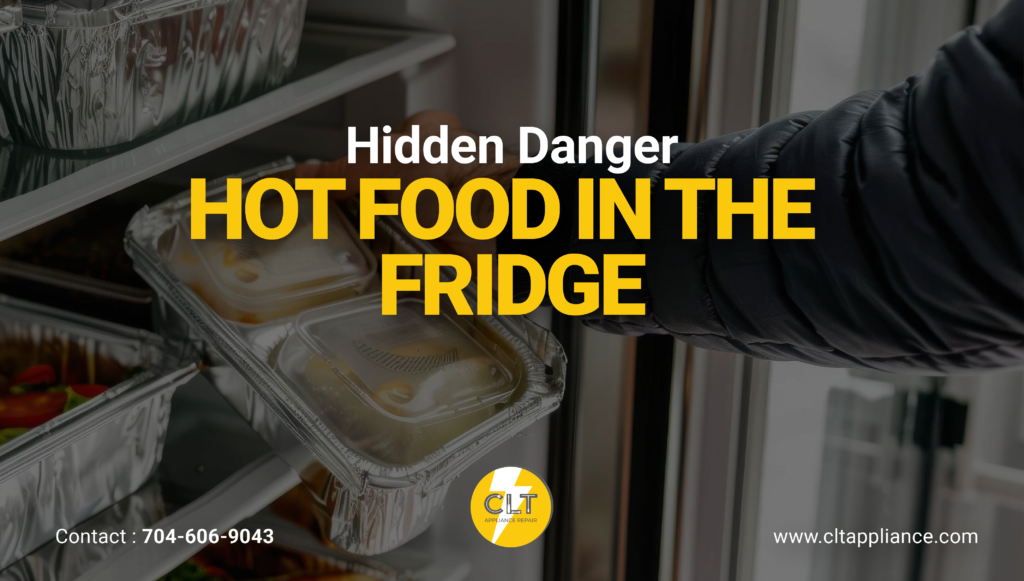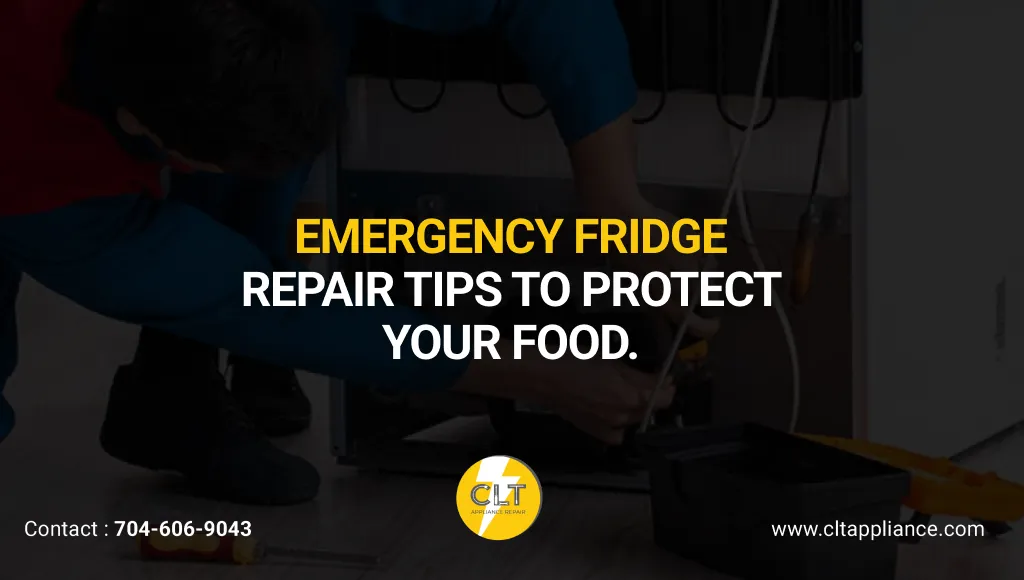In kitchens everywhere, people face a common question after cooking: what to do with leftover hot food. When and how to refrigerate freshly cooked meals involves considerations of food safety, appliance care, and energy use.
Many have received mixed messages about refrigerating hot food. Some learn that food must cool to room temperature first, while others hear that immediate refrigeration prevents illness. Both views have merit, but neither tells the whole story.
Food safety research has established clear guidelines about temperature control and proper handling. These scientific principles help protect both health and appliances, especially since modern refrigerators have changed how we should approach food storage.
Food Safety Considerations When Storing Cooked Meals
The Two Hour Window Makes All The Difference
The “danger zone” is the temperature range between 40°F and 140°F (4°C and 60°C) where bacteria multiply rapidly.
According to food safety authorities like the USDA and FDA, can you put hot food in the fridge? Not only can you, but you should, within 2 hours of cooking. If your kitchen is particularly warm (above 90°F or 32°C), that safe window shrinks to just 1 hour.
This guideline contradicts the old advice that hot food must cool completely before refrigeration. That outdated recommendation actually increases food safety risks.
Bacterial Growth Facts You Need To Know
One concern is whether hot food creates conditions that promote bacterial growth in the fridge. This isn’t true. Bacteria multiply most quickly at room temperature, not in your refrigerator.
Some harmful bacteria produce toxins that remain stable even when you reheat the food later. This is why food safety experts recommend getting cooked food through the danger zone quickly. When people ask “why can’t you put hot food in the fridge?” they’re often working with outdated information.
How Hot Food Affects Your Refrigerator System
While food safety remains the primary concern, many wonder about how refrigerating warm meals impacts their appliance and other stored items.
Modern Versus Older Refrigerator Performance Differences
Most contemporary refrigerators can handle warm food without damage. However, refrigerators older than 20 years often have less robust cooling systems and may struggle to maintain proper temperatures when hot items are introduced.
Energy Consumption And Compressor Strain
Why should you not put hot food in the fridge directly from the stove? One reason is energy efficiency. Hot items raise the internal temperature, forcing the compressor to work harder. This consumes more electricity and can reduce your compressor’s lifespan over time. You might not have to call CLT Appliance Repair experts that often to fix your fridge.
Effects On Surrounding Food Safety
When warm food releases heat inside your refrigerator, it can temporarily warm nearby items, potentially pushing them into the danger zone. Using covered containers helps mitigate this risk.
Condensation And Food Quality Concerns
Can putting hot food in the fridge spoil it or other items? Warm food releases moisture as it cools, creating condensation inside your refrigerator. This excess humidity might accelerate spoilage, cause sogginess, or create an environment where mold develops more readily. Using containers with tight-fitting lids helps prevent these issues.
Best Practices That Keep Your Food Safe And Fresh
Divide Large Portions Into Smaller Containers First
One of the most effective cooling techniques is portion division. Large batches of hot food cool slowly because heat gets trapped at the center. Dividing food into smaller, shallow containers, there is more surface area for faster cooling.
Can you store hot food in the fridge right after cooking? Yes, but smaller portions cool more efficiently. Aim for containers less than 2 inches deep for optimal cooling rates.
Rapid Cooling Methods Before Refrigeration
When you have time, try these effective cooling methods:
- Ice bath method: Place your container of hot food in a larger bowl filled with ice water, being careful not to let water splash into your food.
- Stirring occasionally: For soups and similar dishes, stirring helps release heat more quickly.
- Specialized tools: Consider cooling paddles or ice wands designed for rapidly cooling large batches.
Time Management And Container Selection
Remember that food safety takes priority over refrigerator efficiency. If the 2-hour window is approaching, it’s better to refrigerate warm food than risk bacterial growth.
For proper storage:
- Use shallow containers rather than deep ones
- Select containers with tight-fitting lids
- Leave some space at the top of liquid foods
- Label containers with dates
Common Myths About Refrigerating Warm Meals
When it comes to refrigerating freshly cooked food, several persistent myths continue to circulate. Let’s address these misconceptions with facts.
Bacteria Growth Happens Because Of Refrigeration
Perhaps the most common misconception is that putting hot food in the fridge causes bacteria to grow. This belief likely originated decades ago when refrigerators were less efficient.
The reality is that refrigeration actively slows bacterial growth rather than encouraging it. Bacteria multiply most rapidly at room temperature, not in the cold environment of your refrigerator. The real concern isn’t about refrigerating warm food—it’s about leaving food at room temperature too long before refrigerating it.
Food Must Reach Room Temperature First
Many people believe hot food must cool to room temperature before refrigeration. This advice is not only outdated but potentially dangerous. Allowing food to sit at room temperature for extended periods keeps it in the bacterial danger zone (40°F-140°F) longer than necessary.
Food safety authorities explicitly recommend refrigerating food within 2 hours of cooking, regardless of its temperature. While some cooling can help with energy efficiency, waiting until food reaches room temperature significantly increases food safety risks.
Refrigeration Destroys Food Nutrients
Another concern some people have is that the temperature shock from placing hot food in the refrigerator destroys nutrients. While extreme temperature changes can affect texture in some foods, the impact on nutritional value is minimal.
The greater nutrient loss actually occurs when food is kept warm for extended periods. The food safety benefits of proper refrigeration far outweigh any negligible nutrient changes that might occur.
Hot Food Always Damages Refrigerators
While we’ve discussed that hot food can make your refrigerator work harder, many people believe it will actually damage the appliance. Modern refrigerators are designed to handle reasonable temperature fluctuations.
The main concerns with refrigerating hot food relate to energy efficiency and the potential warming of surrounding foods, not permanent damage to the refrigerator itself. This is especially true for refrigerators manufactured in the last two decades.
Takeaway
Refrigerating food properly balances food safety priorities with practical considerations about your appliance. When asking “is it ok to put food in the fridge hot,” the short answer is yes, with some simple precautions.
The most important guideline to remember is the two-hour rule. This time frame prevents dangerous bacterial growth that can lead to foodborne illness.
CLT Appliance Repair helps Charlotte homeowners maintain their refrigerators at peak performance with expert service. When refrigeration problems arise, their technicians diagnose and repair issues quickly, preventing food spoilage and saving you money on energy costs.
Contact CLT Appliance Repair for professional maintenance to extend your refrigerator’s lifespan.
Frequently Asked Questions
Will refrigerating hot soup crack my glass containers?
Extreme temperature changes can potentially cause glass containers to crack. If using glass containers for hot soup, choose heat-resistant glass designed for temperature changes (like Pyrex), and allow the soup to cool for 10-15 minutes before transferring it to the container and refrigerating.
Should I leave food uncovered in the refrigerator to cool faster?
No, food should always be covered in the refrigerator. While uncovered food might cool slightly faster, it increases the risk of cross-contamination, absorbing odors from other foods, and drying out. Use shallow, covered containers for the best combination of cooling efficiency and food protection.
Is it safe to thaw frozen food on the counter at room temperature?
No, thawing food at room temperature is unsafe as the outer portions enter the bacterial “danger zone” while the center remains frozen. Instead, thaw food in the refrigerator, in cold water (changing the water every 30 minutes), or in the microwave if cooking immediately afterward.
Author

- John Bennett
- John Bennett is a seasoned appliance repair specialist at CLT Appliance Repair, where he brings over a decade of technical expertise and a strong commitment to customer satisfaction. With a background in electrical and mechanical systems, John has built a reputation for reliable, efficient, and honest repair services across a wide range of household appliances-including refrigerators, washing machines, ovens, and more.









